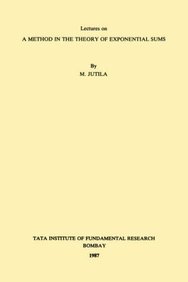
Lectures on a Method in the Theory of Exponential Sums
by M. Jutila
Publisher: Tata Institute of Fundamental Research 1987
ISBN/ASIN: 3540183663
ISBN-13: 9783540183662
Number of pages: 134
Description:
It was my first object to present a selfcontained introduction to summation and transformation formulae for exponential sums involving either the divisor function d(n) or the Fourier coefficients of a cusp form; these two cases are in fact closely analogous. Secondly, I wished to show how these formulae can be applied to the estimation of the exponential sums in question.
Download or read it online for free here:
Download link
(750KB, PDF)
Similar books
 Lectures on The Riemann Zeta-Function
Lectures on The Riemann Zeta-Functionby K. Chandrasekharan - Tata Institute of Fundamental Research
These notes provide an intorduction to the theory of the Riemann Zeta-function for students who might later want to do research on the subject. The Prime Number Theorem, Hardy's theorem, and Hamburger's theorem are the principal results proved here.
(12446 views)
 An Introduction to Modular Forms
An Introduction to Modular Formsby Henri Cohen - arXiv.org
Contents: Functional Equations; Elliptic Functions; Modular Forms and Functions; Hecke Operators: Ramanujan's discoveries; Euler Products, Functional Equations; Modular Forms on Subgroups of Gamma; More General Modular Forms; Some Pari/GP Commands.
(4624 views)
 Lectures on Forms of Higher Degree
Lectures on Forms of Higher Degreeby J.I. Igusa - Tata Institute of Fundamental Research
One of the principal objectives of modern number theory must be to develop the theory of forms of degree more than two,to the same satisfactory level in which the theory of quadratic forms is found today as the work of eminent mathematicians.
(9940 views)
 Analytic Number Theory: A Tribute to Gauss and Dirichlet
Analytic Number Theory: A Tribute to Gauss and Dirichletby William Duke, Yuri Tschinkel - American Mathematical Society
The volume begins with a definitive summary of the life and work of Dirichlet and continues with thirteen papers by leading experts on research topics of current interest in number theory that were directly influenced by Gauss and Dirichlet.
(12456 views)